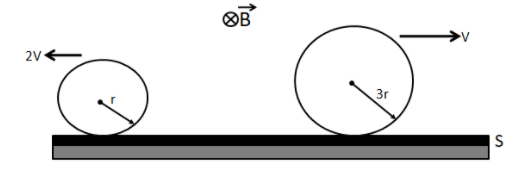
Two conducting rings

Answer
147k+ views
Hint: Note the direction of current for each of the loops and then find the highest and lowest potential points for each of the rings. Find the potential difference between the highest and lowest points for each of the rings from the given magnetic field and radius. The potential of the point on the surface is equal for both of the rings since they are in the same plane.
Find the potential difference between the highest points of the rings from each potential difference of these two rings.
Formula used:
If
The potential difference between two points,
and, if
The potential difference between two points,
Where,
The potential difference,
Complete step by step solution:
For the first ring, the direction of velocity is towards the left side. So if we apply Fleming’s right hand rule, the current is flowing from point
Given,
For the second ring, the direction of velocity is towards the right side. So if we apply Fleming’s right-hand rule, the current is flowing from point
The potential difference ,
Hence, the right answer is in option
Note: The formula used for calculating the potential difference is coming from the equation of induced current in a straight conductor in motion, where the induced current
In the above problem, the length of the straight conductor
Find the potential difference between the highest points of the rings from each potential difference of these two rings.
Formula used:
If
The potential difference between two points,
and, if
The potential difference between two points,
Where,
The potential difference,
Complete step by step solution:
For the first ring, the direction of velocity is towards the left side. So if we apply Fleming’s right hand rule, the current is flowing from point
Given,
For the second ring, the direction of velocity is towards the right side. So if we apply Fleming’s right-hand rule, the current is flowing from point
The potential difference ,
Hence, the right answer is in option
Note: The formula used for calculating the potential difference is coming from the equation of induced current in a straight conductor in motion, where the induced current
In the above problem, the length of the straight conductor
Recently Updated Pages
How to find Oxidation Number - Important Concepts for JEE

How Electromagnetic Waves are Formed - Important Concepts for JEE

Electrical Resistance - Important Concepts and Tips for JEE

Average Atomic Mass - Important Concepts and Tips for JEE

Chemical Equation - Important Concepts and Tips for JEE

Concept of CP and CV of Gas - Important Concepts and Tips for JEE

Trending doubts
JEE Main 2025 Session 2: Application Form (Out), Exam Dates (Released), Eligibility, & More

JEE Main Exam Marking Scheme: Detailed Breakdown of Marks and Negative Marking

JEE Main 2025: Derivation of Equation of Trajectory in Physics

Electric Field Due to Uniformly Charged Ring for JEE Main 2025 - Formula and Derivation

JEE Main Participating Colleges 2024 - A Complete List of Top Colleges

Degree of Dissociation and Its Formula With Solved Example for JEE

Other Pages
JEE Advanced Marks vs Ranks 2025: Understanding Category-wise Qualifying Marks and Previous Year Cut-offs

JEE Advanced 2025: Dates, Registration, Syllabus, Eligibility Criteria and More

JEE Advanced Weightage 2025 Chapter-Wise for Physics, Maths and Chemistry

Electric field due to uniformly charged sphere class 12 physics JEE_Main

Learn About Angle Of Deviation In Prism: JEE Main Physics 2025

Ideal and Non-Ideal Solutions Raoult's Law - JEE




